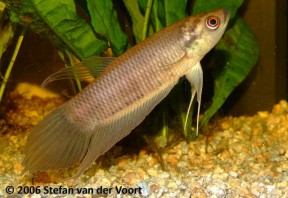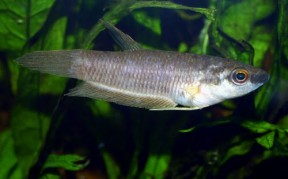Betta renata
Classification
Order: Perciformes Family: Osphronemidae
Distribution
The type specimens were collected close to the settlement of Rantau Panjang in Jambi province on the island of Sumatra, Indonesia. Other collections have occured near the villages of Pematang Lumut and Bertam in Jambi, in the regency of Lahat in South Sumatra (also known as Sumatera Selatan) province and further north from the river Indragiri basin in Riau province.
Habitat
Known only from forest peat swamps and associated blackwater streams. These ancient biotopes are usually found in areas of rainforest, the dense canopy of branches above meaning very little light penetrates the water surface and riparian vegetation also tending to grow thickly.
The water is typically stained darkly with humic acids and other chemicals released by decaying organic material. The dissolved mineral content is generally negligible and the pH can be as low as 3.0 or 4.0.
The substrate is usually covered by fallen leaves, branches and submerged tree roots and at certain times of year the fish may be forced to survive within the moist leaf litter for several weeks as permanent water is not always available.
Maximum Standard Length
80 – 85 mm.
Aquarium SizeTop ↑
An aquarium with base measurements of 90 ∗ 30 cm could house a pair or small group.
Maintenance
Can be maintained in a fully-decorated aquarium although many breeders prefer not to use a substrate for ease of maintenance. Driftwood roots and branches can be used and placed such a way that a few shady spots are formed.
If you can’t find driftwood of the desired shape common beech or oak is safe to use if thoroughly dried and stripped of bark. Clay plant pots or lengths of piping can also be included to provide further shelter.
The addition of dried leaf litter, with beech, oak or Ketapang almond leaves all suitable, can further emphasise the natural feel and as well as offering additional cover for the fish brings with it the growth of microbe colonies as decomposition occurs.
These can provide a valuable secondary food source for fry and the tannins and other chemicals released by the decaying leaves are also considered beneficial for fishes from blackwater environments.
Like others in the genus this species seems to do best under fairly dim lighting. You could add Asian plant species that can survive under such conditions such as Microsorum pteropus, Taxiphyllum barbieri or perhaps some potted Cryptocoryne spp., and a few patches of floating vegetation would be useful to diffuse the light entering the tank.
As it naturally inhabits sluggish waters filtration should not be too strong, with an air-powered sponge filter set to turn over gently adequate. Keep the tank well-covered and do not fill it to the top as like all Betta spp. it requires occasional access to the layer of humid air that will form above the water surface, and is an excellent jumper.
Water Conditions
Temperature: 23 – 27 °C
pH: 4.0 – 6.0
Hardness: 0 – 90 ppm
Diet
Likely to prey on insects and other small invertebrates/zooplankton in nature. Captive fish will normally accept dried products once they’re recognised as edible, but should be offered plenty of small live or frozen foods such as Daphnia, Artemia or bloodworm regularly to ensure development of optimal colour and condition.
Small insects such as crickets or Drosophila fruit flies are also suitable to use; it’s best to fill the stomachs of these by feeding them fish flakes or some kind of vegetable matter before offering them to the fish. Take care not to overfeed as Betta spp. seem particularly prone to obesity.
Behaviour and CompatibilityTop ↑
Not recommended for the standard community set-up for reasons already touched upon. It’s requirements and disposition mean it’s best kept alone or with very peaceful species since much bigger or more vigorous fishes are likely to intimidate and outcompete it. Some small cyprinids and loaches that inhabit similar environments in nature are compatible.
It can be maintained in a pair or group and will display some interesting behavioural interactions under the latter circumstances.
Sexual Dimorphism
Adult males are more colourful, develop more-extended fins and have a broader head shape than females.
Reproduction
Paternal mouthbrooder. Ideally organise a separate tank for breeding purposes, unless the fish are already being maintained alone, setting this up as suggested above. The tank should have the tightest-fitting cover you can find (some breeders use clingfilm instead to ensure no gaps) as the fry need access to a layer of warm, humid air without which development of the labyrinth organ can be impaired.
Following a protracted courtship, eggs and milt are released during an ’embrace’ typical of osphronemids in which the male wraps his body around that of the female. Several ‘dummy’ embraces may be required before spawning commences.
Fertilised eggs are caught on the anal fin of the male then picked up in the mouth of the female before being spat out into the water for the male to catch. Once the male has all the eggs in his mouth the cycle is repeated untill the female is spent of eggs, a process which can take some time.
A brooding male may swallow or release the eggs prematurely if stressed or inexperienced, so it’s preferable to leave the female and any other fishes in situ. The incubation period is 17-20 days at the end of which the male will begin to release fully-formed, free-swimming fry. At this point they can be removed or left to grow alongside the parents, though some may be lost to predation under the latter circumstances.
The fry are large enough to accept motile foods such as microworm and Artemia nauplii immediately, though it should be noted that there exist reports of young Betta developing health issues if fed excessive amounts of the latter. Offer small amounts of different foods 2 -3 times per day for optimal growth rate, and don’t change too much water at once, with regular, small changes preferable to intermittent larger ones.
NotesTop ↑
This species is included in the Betta waseri group/complex of closely-related species within the genus, an assemblage which also includes a handful of potentially new species such as B. sp. ‘Medas’ on an unofficial basis.
Group members share the following combination of characters: base body colouration clay yellow; opercle scales iridescent gold in mature males of all species except B. tomi; throat with black markings which join with black lower jaw in some species; no chin bar.
The easiest way to distinguish these is by examining the throat markings, which vary according to species, and in the case of B. renata form a clearly-defined dark, kidney-shaped blotch on the throat that is always separate from the similarly-coloured lower jaw.
It can also be separated from other group members by the following suite of characters: presence of a kidney-shaped marking on the throat; faint vertical bars on the interradial membranes of dorsal and caudal fins; no dark distal band on anal fin; lower margin of opercle black.
The genus Betta is the most speciose within the family Osphronemidae with almost 70 recognised members and looks set to grow further with new ones continuing to be described on a regular basis since the turn of the century.
Member species have successfully adapted to inhabit a variety of ecological niches from stagnant ditches to flowing hill streams including some extreme environments such as highly acidic peat swamp forests.
The referral of members to a number of groups containing closely-related species is now generally accepted but largely based on morphological/behavioural characters. Molecular phylogenetic work is thus required and would undoubtedly prove useful in more precisely determining relationships between these fishes.
A full list of the species groups as currently recognised can be found here.
Like others in the suborder Anabantoidei this species possesses an accessory breathing organ known as the labyrinth. So-called due to its maze-like structure this organ allows the fish to breathe atmospheric air to a certain extent.
Comprising paired suprabranchial organs formed via expansion of the epibranchial (upper) section of the first gill arch and housed in a chamber above the gills, it contains many highly-vascularised, folded flaps of skin which function as a large respiratory surface. Its structure varies in complexity between species, tending to be better-developed in those inhabiting harsher environments.
References
- Tan, H. H., 1998 - Ichthyological Exploration of Freshwaters 8(3): 281-287
Description of two new species of the Betta waseri group (Teleostei: Osphronemidae). - Schindler, I. and J. Schmidt, 2006 - Zeitschrift für Fischkunde 8(1/2): 47-69
Review of the mouthbrooding Betta (Teleostei, Osphronemidae) from Thailand, with descriptions of two new species. - Tan, H. H. and P. K. L. Ng, 2005 - Raffles Bulletin of Zoology Supplement (13): 115-138
The labyrinth fishes (Teleostei: Anabantoidei, Channoidei) of Sumatra, Indonesia. - Tan, H. H. and P. K. L. Ng, 2005 - Raffles Bulletin of Zoology Supplement (13): 43-99
The fighting fishes (Teleostei: Osphronemidae: Genus Betta) of Singapore, Malaysia and Brunei. - Witte, K.-E. and J. Schmidt, 1992 - Ichthyological Exploration of Freshwaters 2(4): 305-330
Betta brownorum, a new species of anabantoids (Teleostei: Belontiidae) from northwestern Borneo, with a key to the genus.



